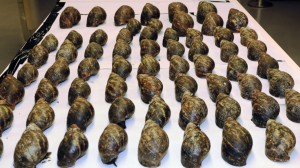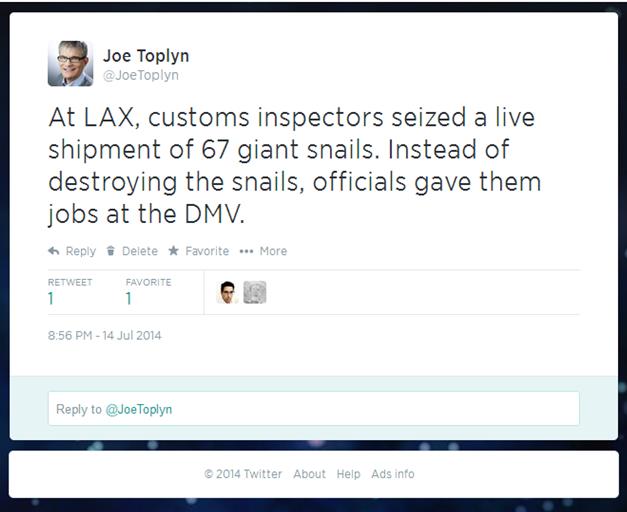There are formulas for writing jokes. Experienced joke writers go through a systematic process to turn something like a news item into a sentence or two that will make people laugh.
You may have heard that “Writing is rewriting.” That describes only part of the process. Writing a joke is first thinking of what to write, then slapping together a rough draft, and only then rewriting to maximize the laugh.
Here’s the process I went through to write a joke for Twitter using the techniques in my book Comedy Writing for Late-Night TV.
The idea for the joke starts with this news headline:
“Giant African Snails Seized at Los Angeles Airport”
I have an emotional reaction to the headline—“That’s weird”—which alerts me that the news item might be of general interest and worth exploring as a joke Topic.
 The news item also feels promising because it has two handles–“snail” and “Los Angeles”—each of which has several well-known associations. That means there’s a great chance I can create a solid Punch Line from the associations. “Snail” has associations like “slimy,” “slow,” and “French people eat them.” “Los Angeles” has associations like “smog,” “traffic,” and all the individual celebrities there.
The news item also feels promising because it has two handles–“snail” and “Los Angeles”—each of which has several well-known associations. That means there’s a great chance I can create a solid Punch Line from the associations. “Snail” has associations like “slimy,” “slow,” and “French people eat them.” “Los Angeles” has associations like “smog,” “traffic,” and all the individual celebrities there.
To generate a Punch Line, I focus first on the well-known “snail” association “slow” and ask myself which slow people are commonly associated with Los Angeles. I can’t think of any only-in-LA slowpokes, so I expand my list of associations to include workers in general.
To spark ideas I Google “slow workers,” which reminds me of the DMV. Ah-ha! Now I have the basis of my Punch Line: I’ll link snails with DMV employees using their shared association “slow.” The result is this:
Partial Rough Draft: “Giant African snails were seized at Los Angeles Airport…workers at the DMV.”
To complete my rough draft I need an Angle that connects my Topic and Punch Line smoothly and efficiently. So I add an Angle that explains how the snails became workers at the DMV and get this:
Rough Draft: “Giant African snails were seized at Los Angeles Airport. Instead of destroying them, officials gave them jobs at the DMV.”
I use the word “officials” a lot in topical jokes. It suggests authority figures but isn’t specific enough to be distracting.
So that’s my rough draft. That was writing, wasn’t it? So much for writing being rewriting. Now comes the rewriting.
I add “live shipment” to clarify that these creatures are animate and could conceivably perform some kind of work. I add “67” because that detail from the news story subtly reinforces that this incident actually occurred. I remove “African” because it’s distractingly specific and unnecessary for the joke. I repeat “snails” in the Angle because it’s so crucial to making the Punch Line work. And this version results:
Version #2: “A live shipment of 67 giant snails was seized at Los Angeles Airport. Instead of destroying the snails, officials gave them jobs at the DMV.”
That version could still use a little tweaking. I backload the Topic, moving the most important elements closer to the Punch Line. I add “customs inspectors” to get rid of the passive voice and to clarify why the snails were seized and might be destroyed. And I get this final version:
Abbreviating the name of the airport took the joke down to exactly 140 characters, Twitter’s limit at the time. That meant I didn’t have to waste more time, and possibly weaken the joke, trimming it to fit.
Before posting the joke I subject it to some Comedy Quality Tests. One of the tests gives me pause: Is the joke too familiar? Is making fun of slow DMV employees similar to making fun of airline food–too hacky? I decide that the joke is so effective that the laugh will blow away any possible whiff of hackiness. Copy and paste to Twitter.



I could use some help if you have a few minutes to spare.
Every once in a while I see a headline that looks like it would make a good topic for a monologue joke, but I spend time on it and get nowhere. Typically the topics that eat up a lot of my time but don’t lead to great punchlines involve political issues or abstract concepts.
Here’s an example of one.
Joe Rogan stated “it’s a fact” that the FBI orchestrated Jan. 6 to damage Trump.
[Rogan’s argument is that a former Marine named Mike Epps has not been charged or convicted for his participation in the insurrection and that’s how Rogan knows Epps was an “agent provocateur.”]
I’ve seen Colbert pull off a bit of sleight of hand by breaking complex topics into a series of shorter, more bite sized chunks.
Colbert would break it down into something like:
1. Joe Rogan stated “it’s a fact” that the FBI orchestrated Jan. 6.
2. Rogan added, The FBI did it to damage Trump.
3. The FBI placed “agents provocateur” in the crowd to incite violence.
and so on…
So I’m curious to know if you have a strategy for handling topics like this. And maybe, if you have a minute, if you might be willing to tell me what handles you would choose for the Rogan topic.
All the best.
What Colbert’s writers do makes sense: they break up a complex news headline–like your Rogan example–into a series of relatively simple topic sentences for jokes.
The topic sentence for a joke has to be relatively simple. More specifically, it has to have only one or two obvious topic handles. Faced with a simple topic sentence like that, the joke writer can guess pretty accurately which topic handles the audience is likely to focus on.
The joke writer wants to guess accurately, because he/she will be basing his/her punch line on those topic handles. If the writer guesses wrong, the joke won’t be immediately clear to the audience and they won’t laugh as hard; remember, my Joke Maximizer #4 is “Make everything clear.”
So break a complex news headline down into a series of related topic sentences that each have only one or two obvious handles. Then write a joke based on each of those simpler topic sentences.
The way you’ve broken down the Rogan headline in your question seems like it would work fine for joke writing.
Thanks for your question.
Joe,
I really like how you explain the punchline makers and joke structure in your book, though I have a question.
Mitch Hedberg was without a doubt one of the greatest writers and performers of monologue jokes, though while I can fit most punchlines into one of your punchline makers, I struggle to understand where a lot of Mitch’s jokes fit.
I’ve listed 3 of Mitch’s jokes below, could you help us all break down these structures and understand which Makers are in effect?
“I like rice. Rice is great if you want to eat 2,000 of something.”
“I had one anchovy. That’s why I didn’t have two anchovies.”
“I used to do drugs. I still do, but I used to, too.”
Thanks!
I agree that Mitch Hedberg was hilarious. While his jokes weren’t topical, he wrote them using the same six Punch Line Makers that I describe in my book.
Here are the Punch Line Makers he apparently used to write those three great jokes:
1) The topic is “I like rice.” Mitch tried Punch Line Maker #3 and asked the question, “Why do I like rice?” He answered that question using an association of the handle “rice,” namely “tiny.” That association has the sub-association “many of them in one serving,” which became the basis of his punch line.
To that rough punch line he applied Joke Maximizer #8 (“Wildly exaggerate”) to get his finished punch line: “2000 of something.”
2) The topic is “I had one anchovy.” This time Mitch tried Punch Line Maker #1. One handle of the topic, “one,” has the association “not two.” The other handle of the topic, “anchovy,” has the association “tastes bad.” Mitch’s punch line links those two associations.
3) The topic is “I used to do drugs.” Mitch turned to Punch Line Maker #4 and based his punch line on a play on words. “Used to” can have two different meanings: “did but don’t now” and “did and still do.”
Thanks for your great question and your kind words about the book!